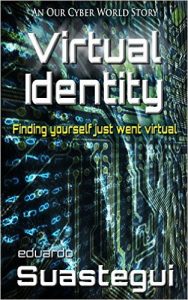
Remember the end of “eXistenZ”? In the 1999 movie starring Jennifer Jason Leigh and Jude Law, they—and we—left that final scene unsure if it was yet another stage in the virtual reality presentation. Jude Law’s character, “virtual reality virgin” Ted Pikul, was pulled and shoved from one insanity to the next by his ignorance of whether he was in a real world or in the virtual reality game.
The entire story of Sandra Tomek and Rodrigo Ochoa in “Virtual Identity” has that same “still in the game” flavor.
You know the queasy thrill when the dead Brian O’Blivion showed up for a TV interview in 1983’s “Videodrome”? The appearance of the virtually-real, yet physically-deceased professor marked the point in the movie when what you knew was real started to spin out of your grasp. In “Virtual Identity,” that point occurs somewhere around the middle of Chapter Two. The James Woods character in “Videodrome,” Max Renn, at least has Harlan, with his condescending “Patronne,” to tell him why he has lost the boundary between reality and television.
Sandra Tomek has no such clue; she has slipped from a real existence to the shifting sands of virtual reality with scarcely a murmur of explanation. In fact, the core story-line of the novel seems to be her search for any stable, truly-real place to stand. Is Rod Ochoa an antagonist? a reluctant co-conspirator? a boyfriend caught in the same sting as Sandra herself? Is Sandra herself the villain, a terrorist-traitor selling secrets, or the innocent pawn of a cloned virtual self? Perhaps she is something entirely unsuspected, defined by shadowy “others” who have trapped her in this VR simulation.
Each new turn in the tale brings Sandra closer to madness, insanity of the kind that Max Renn or Ted Pikul would well understand: “It made her think about who she was, or thought she was, or believed she ought to be, or others expected her to be. Could she or anyone else identify the real Sandra? Did such a person even exist?”
The ongoing confusion about what is real and what is part of the VR simulation, for the reader no less than for Sandra, draws you along. You want to resolve the mystery. You want to find the edible core of this artichoke you are peeling leaf by pointed leaf, but each new layer reveals only another spiny conundrum. At one point, Sandra expresses her frustration with the impossibility of recognizing “real” reality while still wrapped in the haze of virtual-reality madness. “What’s wrong?” she asks Rod, then, “How would we even know?”
This is Volume 9 in the Our Cyber World series, and it includes characters we’ve met before. The focus is so inward, though, that you scarcely need to be familiar with them to be enmeshed in Sandra’s internal quest for identity. In the end, she may find a place to be herself.
How real that terminal identity may be, however, is left as an exercise for the reader.
About The Reviewer:
 Graduated from Colorado School of Mines with a degree in Geological Engineering (mining geology/economics). Married to a CSM mining engineer for 45+ years now. Has 10 brothers and sisters, could fill a small concert hall with nieces, nephews, and their children.
Graduated from Colorado School of Mines with a degree in Geological Engineering (mining geology/economics). Married to a CSM mining engineer for 45+ years now. Has 10 brothers and sisters, could fill a small concert hall with nieces, nephews, and their children.
Lived and/or worked in: UK; Republic of South Africa; 47 of 50 US states; three provinces of Canada; Germany, Holland, and Switzerland. Have been underground in mines on three continents.
Published two editions of his journal of inspirational quotes, “The Social Calendar.” Currently co-writing the non-fictional “Meant To Be Here,” the memoirs of a most interesting man.
Writes flash fiction weekly as one of the Congress of Rough Writers at Carrot Ranch.
Learn more about Pat at “DrPat Reads”
 Remember the end of “eXistenZ”? In the 1999 movie starring Jennifer Jason Leigh and Jude Law, they—and we—left that final scene unsure if it was yet another stage in the virtual reality presentation. Jude Law’s character, “virtual reality virgin” Ted Pikul, was pulled and shoved from one insanity to the next by his ignorance of whether he was in a real world or in the virtual reality game.
Remember the end of “eXistenZ”? In the 1999 movie starring Jennifer Jason Leigh and Jude Law, they—and we—left that final scene unsure if it was yet another stage in the virtual reality presentation. Jude Law’s character, “virtual reality virgin” Ted Pikul, was pulled and shoved from one insanity to the next by his ignorance of whether he was in a real world or in the virtual reality game. Graduated from Colorado School of Mines with a degree in Geological Engineering (mining geology/economics). Married to a CSM mining engineer for 45+ years now. Has 10 brothers and sisters, could fill a small concert hall with nieces, nephews, and their children.
Graduated from Colorado School of Mines with a degree in Geological Engineering (mining geology/economics). Married to a CSM mining engineer for 45+ years now. Has 10 brothers and sisters, could fill a small concert hall with nieces, nephews, and their children.